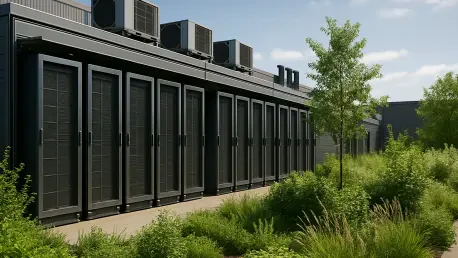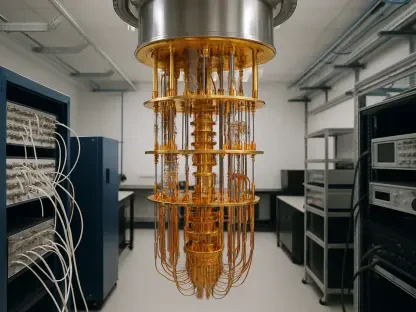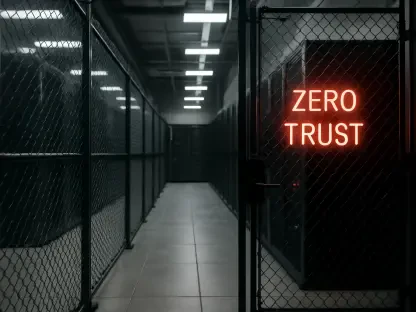Imagine a world where the backbone of the digital economy—data centers—operates without consuming a single drop of water, even as global water scarcity intensifies, and the tech industry faces growing pressure to reduce its environmental footprint. Data centers, which traditionally consume millions of gallons of water annually for cooling, confront a critical challenge, and this review dives into the emerging technology of water-free data centers, exploring how innovative cooling methods could redefine sustainability in digital infrastructure and address one of the most pressing resource issues of the modern era.
Technological Foundations of Water-Free Cooling
Liquid Immersion Cooling
At the forefront of water-free data center technology lies liquid immersion cooling, a method that submerges IT equipment in non-conductive fluids to absorb heat directly. Unlike traditional water-based evaporative cooling, this approach eliminates water dependency entirely, using specialized liquids that transfer heat efficiently without risk of electrical damage. The result is a dramatic reduction in resource use, aligning with sustainability goals in regions where water is scarce.
Beyond its environmental benefits, liquid immersion cooling offers impressive energy efficiency by minimizing the need for extensive air circulation systems. However, the high upfront costs of installing specialized tanks and fluids pose a significant barrier to widespread adoption. For many operators, the financial investment may outweigh the benefits unless long-term savings or regulatory incentives come into play.
This technology also demands meticulous maintenance to prevent fluid degradation or leaks, adding to operational complexity. Despite these hurdles, its potential to revolutionize cooling in high-density computing environments makes it a compelling option for forward-thinking companies committed to zero water usage.
Mechanical Cooling Systems
An alternative to immersion techniques, mechanical cooling systems adapt traditional air conditioning principles to manage server temperatures without water. These systems circulate chilled air through data center spaces, often enhanced by innovations like direct-to-chip cooling, where coolants target specific components, or sealed server cabinets that optimize airflow. This method provides a more familiar and often less expensive pathway to water-free operations.
Energy consumption remains a critical drawback, as mechanical cooling can require substantial electricity to maintain optimal temperatures, especially in warmer climates. The tradeoff between water savings and energy use often depends on access to renewable power sources, which can mitigate the environmental impact of higher electricity demands.
Recent advancements in system design, such as integrating more precise cooling delivery, have improved efficiency and reduced some energy overhead. For organizations prioritizing cost over cutting-edge efficiency, mechanical cooling serves as a practical stepping stone toward sustainability without the steep investment of immersion alternatives.
Industry Trends and Innovations
The push for water-free data centers reflects a broader industry trend toward sustainability, with water usage effectiveness (WUE) becoming a key metric for environmental performance. Achieving a WUE of 0 liters per kilowatt-hour has evolved from an ambitious dream to a tangible target, driven by regulatory pressures and public demand for greener tech practices. Hybrid cooling solutions, combining elements of immersion and mechanical systems, are gaining traction as a way to balance efficiency and affordability.
Innovations in system architecture also play a pivotal role, with designs focusing on heat recapture and modular setups that minimize resource waste. Companies are increasingly exploring how to integrate these technologies into existing facilities, reducing the need for entirely new infrastructure builds. Such adaptability could accelerate adoption in the coming years, especially as pilot projects yield actionable data.
Environmental concerns are not the only driver; operational resilience in water-scarce regions adds urgency to the shift. As more tech giants commit to sustainability pledges, the momentum behind water-free cooling continues to build, positioning it as a cornerstone of next-generation data center strategies.
Real-World Implementations and Case Studies
Several industry leaders are pioneering water-free data center initiatives, demonstrating the technology’s viability in practical settings. Microsoft, for instance, has committed to testing water-free cooling in select facilities, focusing on regions with limited water access to maximize impact. Their approach often integrates mechanical systems with advanced heat management, showcasing a scalable model for others to follow.
NOVVA, a data center provider, has also embraced water-free designs in arid locations, leveraging mechanical cooling to eliminate water use while maintaining operational uptime. Their projects highlight how location-specific challenges can drive innovation, offering valuable lessons for operators in similar environments.
Vertiv, a key player in cooling technology, supports these efforts by developing tailored solutions for water-free setups. Their collaborations with data center operators underscore the importance of customized equipment in overcoming site-specific hurdles, proving that real-world applications can thrive with the right partnerships and strategic planning.
Challenges in Scaling Water-Free Solutions
Despite promising developments, the path to widespread adoption of water-free data centers is fraught with obstacles. High initial costs remain a primary concern, particularly for liquid immersion cooling, which requires specialized infrastructure that many smaller operators cannot afford. This financial barrier limits the technology to well-funded enterprises or niche applications.
Energy tradeoffs further complicate the landscape, as mechanical cooling systems often increase electricity consumption, negating some environmental gains unless paired with renewable energy sources. Striking a balance between water and energy sustainability demands careful planning and access to green power, which is not universally available.
Scalability issues also loom large, as retrofitting existing facilities with water-free systems can be logistically complex and disruptive. While new builds can incorporate these technologies from the ground up, the majority of current infrastructure requires significant adaptation. Addressing these challenges through cost reductions and modular designs will be crucial for broader implementation.
Future Prospects and Potential Impact
Looking ahead, the trajectory of water-free data centers appears promising, with ongoing research focused on reducing costs and enhancing energy efficiency. Innovations in cooling fluids and system integration could lower financial barriers, making the technology accessible to a wider range of operators. If successful, these advancements might redefine industry standards over the next few years.
The long-term impact extends beyond individual facilities, potentially influencing global policies on resource use in tech infrastructure. As water scarcity worsens in many regions, water-free cooling could become a regulatory requirement rather than an optional upgrade, reshaping how digital economies address sustainability.
Collaboration between tech companies, equipment manufacturers, and policymakers will be essential to drive this transformation. By aligning incentives and sharing best practices, the industry can accelerate the shift to water-free operations, ensuring that digital growth does not come at the expense of critical natural resources.
Final Thoughts
Reflecting on this exploration of water-free data centers, the journey revealed a technology brimming with potential yet tempered by practical constraints. The review highlighted how liquid immersion and mechanical cooling tackled water dependency head-on, while case studies from industry pioneers like Microsoft and NOVVA proved that real-world applications were not just theoretical. Challenges around cost and energy use stood out as significant hurdles that demanded attention.
Moving forward, the industry must prioritize investment in cost-effective innovations to democratize access to these solutions. Strategic partnerships should focus on integrating renewable energy to offset electricity demands, ensuring a holistic approach to sustainability. Additionally, policymakers could consider incentives for early adopters, catalyzing broader uptake. The road ahead for water-free data centers calls for collective action to transform a compelling concept into a cornerstone of sustainable digital infrastructure.









